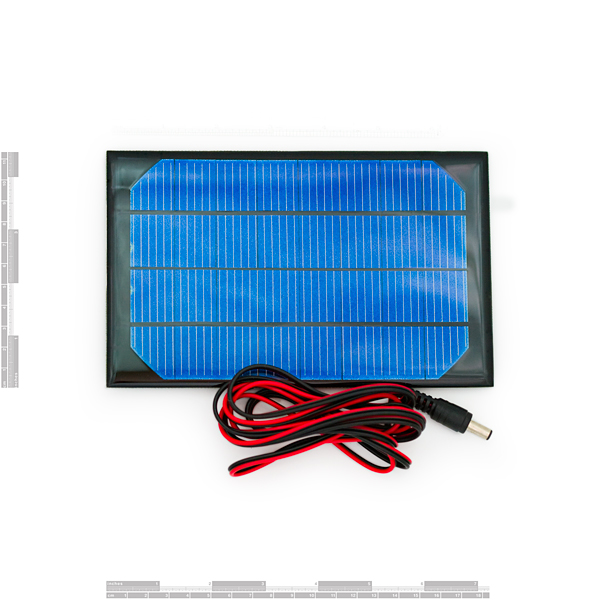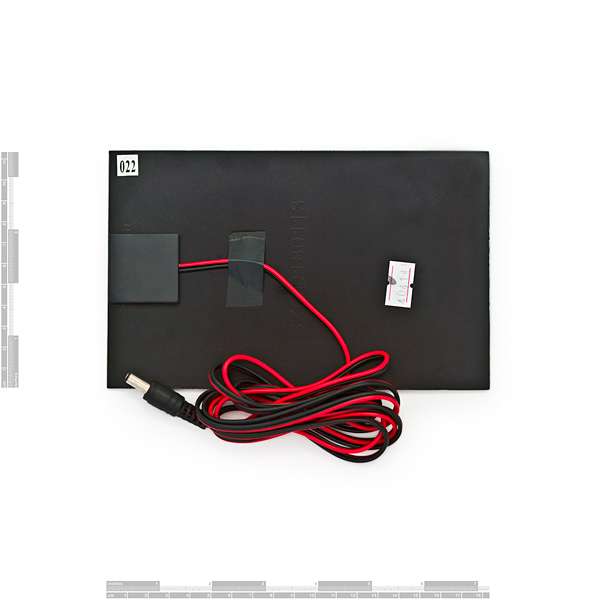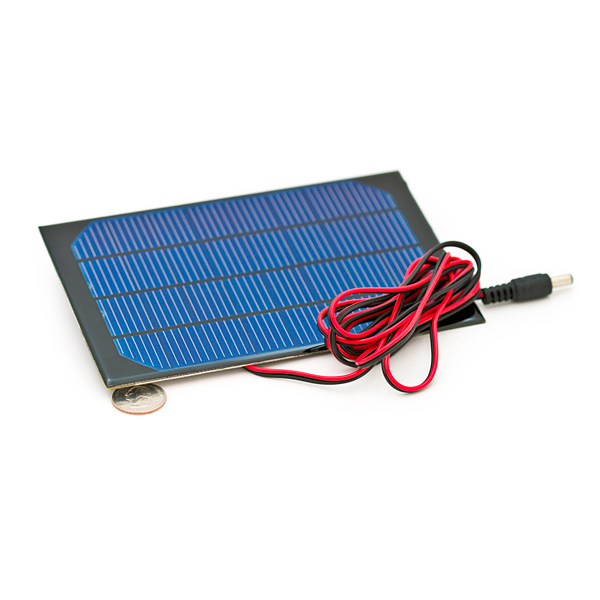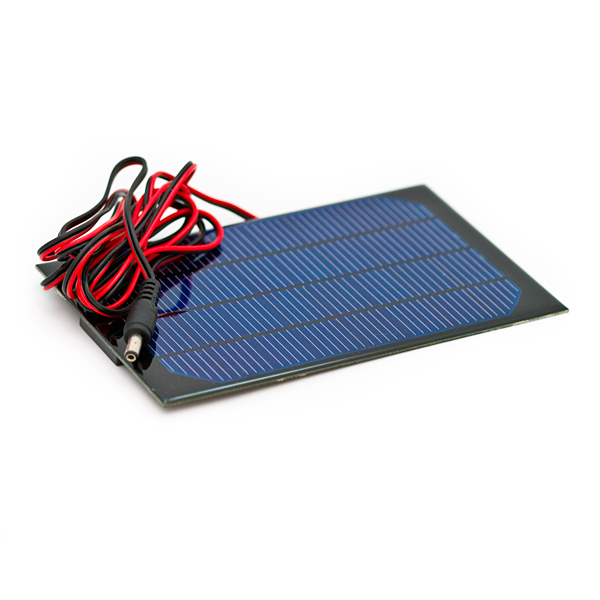Solar Cell Large - 2.5W
Packaged solar cell with barrel plug termination. This is a custom cell produced for SFE - not a small toy surplus item! This unit is rated for 8V open voltage and 310mA short circuit. We actually took a random unit outside and measured 9.15V open voltage and 280mA short circuit. Under ideal sun conditions (high-noon, clear sky) 310mA is very possible but will vary from cell to cell. We can even get 110mA from inside our office windows!
Termination is a 5.5mm x 2.1mm barrel plug, center positive on a 2m cable. Monocrystalline high efficiency cells at 15-15.2%. Mates directly with many of our development boards. Unit has a clear epoxy resin coating with hard-board backing. Robust sealing for out door applications!
- 7 x 4.5"
Solar Cell Large - 2.5W Product Help and Resources
Core Skill: Electrical Prototyping
If it requires power, you need to know how much, what all the pins do, and how to hook it up. You may need to reference datasheets, schematics, and know the ins and outs of electronics.
Skill Level: Noob - You don't need to reference a datasheet, but you will need to know basic power requirements.
See all skill levels
Comments
Looking for answers to technical questions?
We welcome your comments and suggestions below. However, if you are looking for solutions to technical questions please see our Technical Assistance page.
Customer Reviews
4 out of 5
Based on 2 ratings:
1 of 1 found this helpful:
Hey, this ain't too shabby
This is actually a really nice solar cell. I buy these over other cells available online, as they pack quite a punch for their size. Sparkfun, well done.
It works well
This panel worked as expected. I recommend it for lower power requirements!





I want to use this solar panel to charge batteries powering my arduino remote logging station, which battery charger and battery will this solar panel work well with ?
This weighs about 100 grams, not including the cord.
There is no built in diode.
I posted a voltage/current curve on the web page below but it's under artificial light so I don't know exactly what its peak output is in real sunlight. I would estimate somewhere around 1.5-2.0 watts.
http://jormungand.net/dev/solar/
Thanks for this. How thick is it? 3-5mm?
A heads up for people planning to use this for permanent outdoor mounting: The epoxy coating is not UV protected. After 6 months outside in Hawaii, mine has become completely opaque. It's still functioning, but I have no idea how much power I'm losing.
Seems odd that a product designed to be used in the sun is not protected against UV damage!
Are there any chances of getting a data sheet for this? I would like to know the output impedance, IV curve, etc.
Does anyone know how much this solar panel weigh? Thanks.
I want to use this device for a college project, a robot follows lines, the design is based on a military tank and uses three photo-sensors on bottom. Do you think that this device produces enough energy to power the robot? the robot its smaller than 10cm by 10cm
I have purchased 4 of this for an outdoor project. Will order 12 more if the product meets requirements...
I recently bought this product, will it charge a 2200Mah 11.1V LiPo battery?
Hey Mike, I am thinking of using this to power a Power Cell - LiPo Charger/Booster sku: PRT-10300 can I do so without blowing up said charger booster or will I need some sort of 5v regulator and what would that do the performance of the output of the cell.
According to the datasheet for the MCP73831 chip on the charger, the absolute maximum input is 7V. Which is a problem, because this panel can get up to 8V.
You've got a couple options though. One is, as you say, running the panel through a 7805 before hitting the charger. You'll lose some efficiency (and voltage margin in low-light conditions), but sunlight is free and this is an easy fix.
Another option is a simple zener shunt on the output of the panel. This circuit increasingly shorts power to ground if the voltage ever gets above 7V. I made one for exactly this purpose (this panel and this charger) out of a 6.8V zener and a small resistor. It does work; you lose a bit of power in the resistor, but not much.
We've working on some solar-power products, but I wouldn't expect them to appear on the storefront before fall at the earliest. In the meantime, the above two techniques should help get your project off the ground. Good luck!
How small resistor did u use? thx!
I believe it was 10 ohms.
Two more questions :P What about using a large cap for filtrering and boosting the input to the charger? When will there be a line up with Sparkfun solar power products? :) thx!
can i use this panel with arduino uno?
Yes, it works very nicely with an Arduino.
can i use this panel with arduino uno?
Is there a datasheet for this panel?
All of the relevant data should be in the product post - anything in particular you're looking for?
Interested in the manufacturer's IV curve (I saw the user post above), ambient temp specs for operation etc...
I second the request for IV curve.
From the picture, this cell looks blue. Is it really blue or is that just the lighting in the photograph?
I am working on a robot project that involves a number of solar cells. I already have four of the "Huge" cells (PRT-09241). Those are black. I am now considering a couple of the "Large" cells (PRT-07840) for the same project, but it's only going to work for me if the "Large" cells are black like the "Huge" cells.
can i sand down the sides to 4.25 fit in a pelican case Micro Case 1060
I'd be very careful as you don't know where the traces are.
I'm looking for a solar cell/motor combo that can work and propel in sunlight, not one of these solar projects that quiver after charging a capacitor. Will this panel work and what motor works in combo w/it?
I would also like to know how to charge a battery. I guess I need some kind o regulator when the battery is full.
Thanks in advance!
I would also like to know about charging a battery using this cell...
For now I will be using the Koala (PRT-08722) and the ~1Ah LiPo (PRT-00339)
Thanks!
Does this have a diode to protect from destroying the cells while charging a battery?
Do you have the Power/Voltage curve for this panel? Do you know what the peak Voltage*Current is (Peak Power I guess?)?